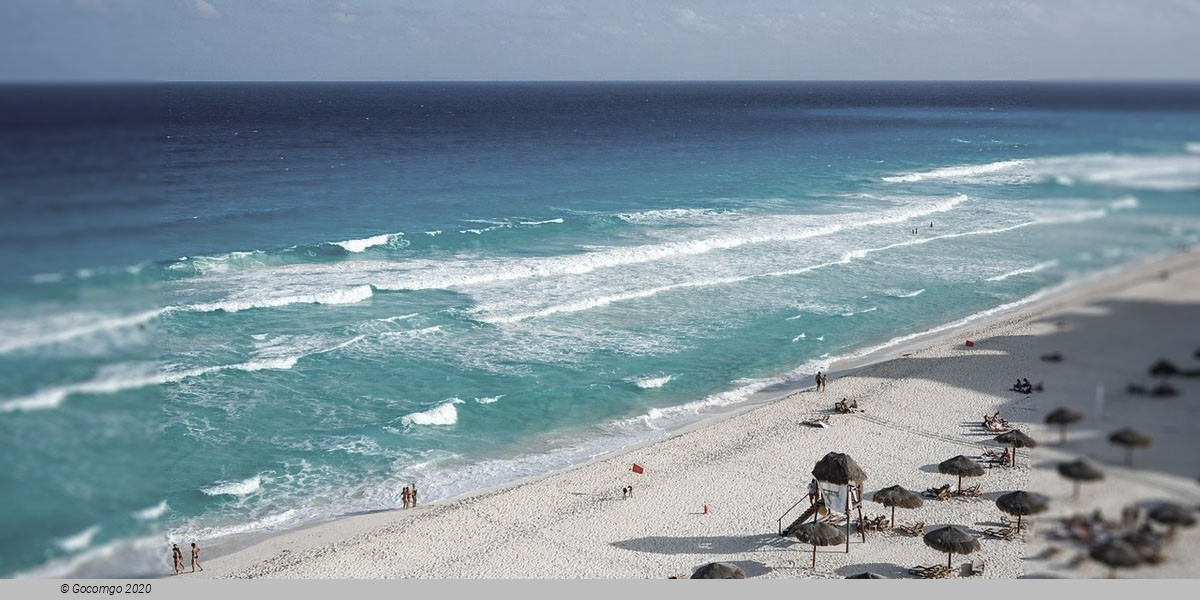Cancun

Cancún is a city in southeast Mexico on the northeast coast of the Yucatán Peninsula in the Mexican state of Quintana Roo. It is a significant tourist destination in Mexico and the seat of the municipality of Benito Juárez. The city is on the Caribbean Sea and is one of Mexico's easternmost points. Cancún is just north of Mexico's Caribbean coast resort band known as the Riviera Maya. In older English-language documents, the city’s name is sometimes spelled "Cancoon", an attempt to convey the sound of the name.
History
As documented in the earliest colonial sources, Cancún was originally known to its Maya inhabitants as Nizuc (Yucatec Maya [niʔ suʔuk]) meaning either "promontory" or "point of grass". In the years after the Conquest, much of the Maya population died off or left as a result of disease, warfare, piracy, and famines, leaving only small settlements on Isla Mujeres and Cozumel Island.
The name Cancún, Cancum or Cankun first appears on 18th-century maps. The meaning of Cancún is unknown, and it is also unknown whether the name is of Maya origin. If it is of Maya origin, possible translations include "Place/Seat/Throne of the Snake" or "Enchanted Snake". Snake iconography was prevalent at the pre-Columbian site of Nizuc.
When development of the area as a resort was started on January 23, 1970, Isla Cancún had only three residents, all caretakers of the coconut plantation of Don José de Jesús Lima Gutiérrez, who lived on Isla Mujeres. Some 117 people lived in nearby Puerto Juárez, a fishing village and military base.
Due to the reluctance of investors to gamble on an unknown area, the Mexican federal government financed the first nine hotels. The first financed hotel was a Hyatt, Cancún Caribe, but the first hotel built was the Playa Blanca, which later became a Blue Bay hotel. It is now named Temptation Resort. At the time it was an elite destination, famous for its virgin white sand beaches.
The city began as a tourism project in 1974 as an Integrally Planned Center, a pioneer of FONATUR (Fondo Nacional de Fomento al Turismo, National Fund for Tourism Development), formerly known as INFRATUR. Since then, it has undergone a comprehensive transformation from being a fisherman's island surrounded by virgin forest and undiscovered shores to being one of the two most well-known Mexican resorts, along with Acapulco. The World Tourism Organization (WTO), through its foundation UNWTO-Themis, awarded the Best of the Best award "for excellence and good governance" to the Trust for Tourism Promotion of Cancún on February 3, 2007. This award ensured Cancún the ongoing support of the Department of Education and Knowledge Management of the WTO.
Most 'Cancunenses' are from Yucatán and other Mexican states. A growing number are from the rest of the Americas and Europe. The municipal authorities have struggled to provide public services for the constant influx of people, as well as limiting squatters and irregular developments, which now occupy an estimated ten to fifteen percent of the mainland area on the fringes of the city.
City layout
Apart from the island tourist zone (part of the world's second-longest coral reef), the Mexican residential section of the city, the downtown part of which is known as "El Centro", follows a master plan that consists of "supermanzanas" (superblocks), giant trapezoids with a central, open, non-residential area cut in by u-shaped residential streets.
Ave. Tulum is the main north-south artery, connecting downtown to the airport, which is some 30 km (19 mi) south of downtown. Tulum is bisected by Ave. Cobá. East of Ave. Tulum, Cobá becomes Ave. Kukulcan which serves as the primary road through the 7-shaped hotel zone. Ave. Tulum ends on the north side at Ave. Paseo José López Portillo which connects to the main highway west to Chichén Itzá and Mérida. Another major north-south road is Ave. Bonampak which runs roughly parallel to Ave. Tulum. The main ferry to Isla Mujeres is located in Puerto Juárez, on Ave. Paseo José López Portillo.
Cancún's mainland or downtown area has diverged from the original plan; development is scattered around the city. The remaining undeveloped beach and lagoon front areas outside the hotel zone are now under varying stages of development, in Punta Sam and Puerto Juarez to the north, continuing along Bonampak and south toward the airport along Boulevard Donaldo Colosio. One development abutting the hotel zone is Puerto Cancún; also Malecon Cancún is another large development.

